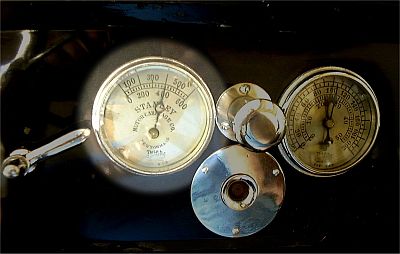
steam
pressure gauge (left) located on the dashboard. the dash light is located to the right and
the winker below and right.
| STEAM PRESSURE GAUGE | |

steam
pressure gauge (left) located on the dashboard. the dash light is located to the right and
the winker below and right. |
The boiler steam pressure is displayed on a gauge on the dashboard. The steam pressure gauge is located to the left of the fuel systems gauge. The scale of the gauge displays a maximum of 600 PSIG. Due to the pressures contained within the mechanism of the gauge, this gauge has and exceptionally thick bezel glass should a leak occur within the gauge case. |
|
HOW THE STEAM GAUGE OPERATES |
|
Bourdon Spring or Tube Gauges use a coiled tube bent in the shape of a horseshoe. The bourdon tube was commonly made of seamless tubing, drawn from phosphor-bronze, rolled to a curvature and surface hardness which insured operating accuracy. One end is attached to a pressure or vacuum source and the other end is closed off and attached through a metal linking arm to a pointer. The bent tube or spring has a tendency to straighten slightly when pressure is introduced. This straightening action is conveyed to a pointer that has been calibrated to various pressures on a round dial. The movements were usually of the geared type, having a small gear (rack) attached to the pinion (shaft where the pointer attached). The sector was connected to the movement with another shaft and while one end of the sector contacted the rack, the other was linked to the tube spring. Thus, the movement of the tube spring was conveyed to the pointer through the movement of the sector and then rack and finally the pinion. Usually, the movement was made of phosphor-bronze or German Silver.
The index pointer of the gauge was made of brass in keeping with the corrosive resistance requirements of constant exposure to steam. Brass was also chosen because it was easily stamped into shape. The index pointer of the gauge is of the "Fixed Pointer" type. The most obvious characteristic of this type of pointer is the requirement to remove it when calibration forces repositioning. Unlike its modern counter part with its stream-lined perfectly balanced shape, the old pointers were designed primarily for enhanced appearance. One of the problems with any gauge mounted on something that vibrated was vibration being transmitted to the pointer causing it to bounce around thus making it difficult to obtain accurate readings. In the late 1850s T. W. Lane patented (Patent No. 23,032, dated February 22, 1859), a gauge design that corrected the bouncing needle effect. This improvement was later adopted by many gauge manufacturers and was known as the double spring Bourdon gauge. Known as "Lane's Improvement" the double bourdon spring gauge design readily lent itself to use in high vibration environments as found on locomotives, portable engines, traction engines, and steam carriages. The unique configuration of two separate Bourdon springs attached to a single movement proved invaluable in reducing the fluctuations caused by severe vibration. The catalog page and bourdon tube gauge information is courtesy of Barry David and his book "The Antique American Steam Gauge, A Collector’s Guide" (available at www.astragalpress.com). It is interesting to note that while these gauges sold for $16.50 originally, today they typically sell for several hundred dollars when one is lucky enough to find one. |